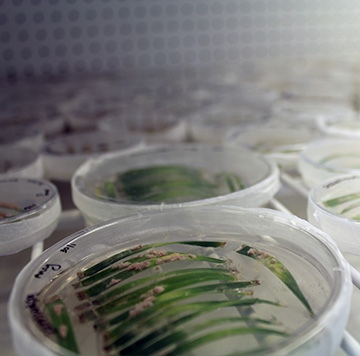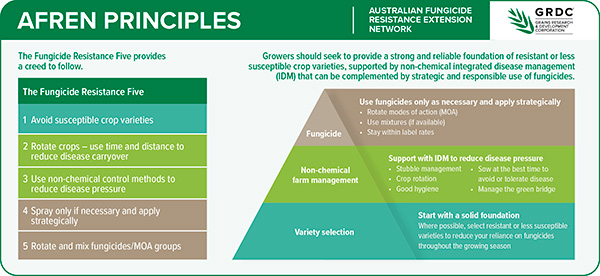Paddock Practices: Potential for fungicide resistance detected in Esperance wheat powdery mildew
Paddock Practices: Potential for fungicide resistance detected in Esperance wheat powdery mildew
Date: 12 Mar 2025

Key points
- Laboratory analysis of wheat powdery mildew samples from Esperance, WA has detected a mutation with the potential for Group 3 (DMI) fungicide resistance.
- The mutation is not currently linked to any observed reduction in fungicide performance, but growers should monitor crop performance and manage fungicide use carefully.
- This detection follows Group 3 and Group 11 resistance trends in the Eastern states
- Use the ‘Fungicide Resistance 5’ (FR5) to minimise disease pressure and the risk of favouring DMI-resistance mutations in the pathogen population.
- Only use Group 3 fungicides in mixture and rotation with other fungicide groups.
Overview
Laboratory analysis of wheat powdery mildew samples collected from the Esperance district in Western Australia has revealed the presence of a gateway mutation that could lead to reduced sensitivity or resistance to azole/demethylase inhibitor (DMI) fungicides.
While there have been no reported incidents of reduced fungicide performance in the paddock linked to this mutation, growers should be careful to apply fungicides in rotation and mixture, and practice non-chemical disease management strategies to avoid creating favourable circumstances for resistance to develop.
How resistance was detected
Each season the WA Department of Primary Industries and Regional Development (DPIRD) Crop Protection team in Esperance (Andrea Hills and Joel Kidd) submit wheat powdery mildew samples to the Centre for Crop and Disease Management (CCDM) at Curtin University for fungicide resistance testing.
Of the 13 samples submitted in 2024, ten contained a genetic mutation that isa forerunner of fungicide resistance. This type of mutation is called a gateway mutation. A gateway mutation could lead to further mutations. In this case, further mutations could impact the performance of Group 3 DMI fungicides such as cyproconazole, epoxiconazole, flutriafol, propiconazole, prothioconazole, tebuconazole and triadimefon.
Wheat powdery mildew is a constant factor in the Esperance district. Paddocks where disease levels were high in previous seasons are especially at risk.
Resistance to Group 3 and Group 11 fungicides
Reduced sensitivity to Group 3 fungicides associated with a gateway mutation was first reported in Tasmania in 2015. Resistance to Group 3 fungicides propiconazole and tebuconazole emerged in NSW and Victoria in 2020.
The resistance and reduced sensitivity to Group 3 fungicides probably arose through growers using a single-mode-of-action fungicide to control disease in susceptible cultivars of wheat grown in high rainfall areas.
It’s a similar story for resistance to Group 11 fungicides. Resistance to both these fungicide groups is now widespread in all states across the southern growing region and into southern Queensland in the northern growing region.
Group 3 and Group 11 fungicides are currently still effective for control of wheat powdery mildew in WA. Growers can take action to support the long-term efficacy of DMI fungicides for controlling wheat powdery mildew.

Factors influencing fungicide resistance
Western Australia’s benchmark wheat variety Scepter is rated susceptible (S) for wheat powdery mildew. The next two most popular varieties, Vixen and Calibre, are rated susceptible/very susceptible (SVS) and moderately susceptible/susceptible (MSS) respectively.
In combination with favourable wet conditions and a few days above 25oC, using these varieties can increase disease pressure in the Esperance region from May to October.
Fungicides are an important tool for disease control. However, their regular use has also increased the risk that crops will develop fungicide resistance.
Grower actions
Fungicide resistance and reduced sensitivity are not the only reasons you may see poor disease control in a crop. Under extreme disease pressure, fungicides can be less effective. Other reasons include poor timing of application, spraying in inclement weather or using ineffective rates that may result in poor spray penetration into the canopy.
Keep accurate records, taking care to ensure fungicides are correctly applied. Monitor crops after spraying. Accurate record-keeping and monitoring can help you understand whether reduced effectiveness of fungicide could be due to resistance or reduced sensitivity. This will be useful when discussing management options with your agronomist.
Follow the AFREN ‘FR5’ principles to leverage non-chemical disease management strategies for reducing disease pressure. Use fungicides only as necessary to protect yields. The FR5 is built on avoiding the most susceptible varieties and managing the crop to reduce disease pressure.
Support disease control with later sowing and careful management of nitrogen levels. Early sowing and high nitrogen rates can increase susceptibility to wheat powdery mildew. Strong vegetative growth can increase canopy density which in turn can lead to high humidity and limit the ability of fungicide sprays to penetrate. This can then result in conditions that favour disease outbreaks.
Scepter remains the favoured high-yielding Australian Hard (AH) wheat variety in Western Australia. However, new varieties are coming through the National Variety Trials program that combine competitive yields with options for later sowing.
Consult the DPIRD 2025 Western Australian Crop Sowing Guide or an agronomist to identify suitable new varieties for your growing conditions.
Support variety selection with regular crop rotations and good farm hygiene. Barley, pulses and oilseeds can all provide an effective break. Eliminating volunteer wheat plants in break years is essential for preventing disease carry-over.
Fungicide management
Esperance district growers do not need to stop using particular Group 3 fungicides to control wheat powdery mildew in the paddock. Follow single active applications with mixtures containing a different fungicide group.
Apply Group 3 products in rotation or in mixture with a fungicide from a different group. This exposes the pathogen population to a fungicide with an alternative target. It will help control inoculum that may have survived the Group 3 application due to the presence of resistant individuals.
Avoid more than one application each of Group 7 or Group 11 products (whether solo or in mixture) per growing season. Avoid more than three applications of Group 3 products per growing season. The fungicide rotation program must also consider any seed dressing or in-furrow treatment with foliar activity.
Consider the risk of wheat powdery mildew developing resistance to Group 3 and Group 11 fungicides when using these fungicides to treat other foliar diseases in the paddock.
Other available fungicide options for the control of what powdery mildew are:
- metrafenone (Group 50)
- quinoxyfen (Group 13) and
- proquinazid (Group 13).
The 2023 emergency permits (PER93197, PER93216, PER93198) for these fungicides has been extended until 2027. However, the high specificity of these active ingredients means that they will have a limited impact on any other fungal disease in the crop.
AFREN principles recommend applying fungicide at the first signs of disease, while infection levels are still low. They also recommend holding back fungicide applications if there is no sign of disease or if weather conditions are not likely to remain conducive.
Carefully monitor the effectiveness of every Group 3 fungicide application to control wheat powdery mildew. Discuss any sign of reduced effectiveness with an agronomist. If you or your agronomist suspect fungicide resistance or reduced sensitivity, the CCDM will accept samples for laboratory testing.

Image description
AFREN Principles provided by the Australian Fungicide Resistance Extension Network (AFREN)
The Fungicide Resistance Five provides a creed to follow.
- Avoid susceptible crop varieties
- Rotate crops – use time and distance to reduce disease carryover
- Use non-chemical control methods to reduce disease pressure
- Spray only if necessary and apply strategically
- Rotate and mix fungicides/MOA groups
Growers should seek to provide a strong and reliable foundation of resistant or less susceptible crop varieties, supported by non-chemical integrated disease management (IDM) that can be complemented by strategic and responsible use of fungicides.
Fungicide
Use fungicides only as necessary and apply strategically
- Rotate modes of action (MOA)
- Use mixtures (if available)
- Stay within label rates
Non-chemical farm management
Support with IDM to reduce disease pressure
- Stubble management
- Crop rotation
- Good hygiene
- Sow at the best time to avoid or tolerate disease
- Manage the green bridge
Variety selection
- Start with a solid foundation
- Where possible, select resistant or less susceptible varieties to reduce your reliance on fungicides throughout the growing season.
Useful resources
- AFREN website: Wheat powdery mildew
- 2025 Western Australian Crop Sowing Guide
- Foliar fungicides registered for use on wheat in WA – 2024-25
- DPIRD Digital Library: Powdery mildew and its management in wheat (PDF)
- GRDC Update Paper (February 2019): Wheat powdery mildew epidemiology and crop management options
- GRDC Factsheet: Fungicide-resistant wheat powdery mildew (Oct 2024)
More information
Andrea Hills
Senior Research Scientist, Grains – Crop Protection – Virology
WA Department of Primary Industries and Regional Development
andrea.hills@dpird.wa.gov.au
08 9083 1144 | 0488 575 091
Nola D’Souza
AFREN Project Coordinator,
Centre for Crop and Disease Management, Curtin University
nola.dsouza@curtin.edu.au
08 9266 3541
GRDC Project Code: CUR2302-002RTX,
